Book contents
1 - ROMAN AND BARBARIAN PRECEDENTS
Published online by Cambridge University Press: 03 December 2009
Summary
THE GRANDEUR THAT WAS ROME
History is an ever-changing continuum; without some account of the earlier period, we can hardly understand why the Commercial Revolution was at the same time the end product of a long tradition and the beginning of a new one.
The great expansion of the later Middle Ages succeeded a great contraction in the early Middle Ages, which in turn had come after the expansion of the Classic Ages. This alternation of crest, trough, and crest can be observed not only in the economic field, but in almost every aspect of life: literature and art, philosophy and thought, politics and law also were affected, though not all to the same extent. The greatest achievements of the Greeks and the Romans were not in the economic field; yet the inventiveness of the former and the efficiency of the latter were more than enough to make the Greco-Roman economy the most successful one in the recorded history of antiquity. Let us take a quick glance at its main traits in the prime of the Roman Empire, that is, approximately, from Augustus (29 B.C.–A.D. 14) to Marcus Aurelius (161–180).
All along the broad belt of territory around the Mediterranean Sea, which formed the spine of the Empire, the population had grown and lengthened its life expectancy. It is true that the average span was about twenty-five years, but this is not much less than that of Egypt in 1948 (thirty-one years) or China in 1946 (thirty-five years), which had then both been affected by another fifteen centuries of medical and technological progress.
- Type
- Chapter
- Information
- Publisher: Cambridge University PressPrint publication year: 1976



